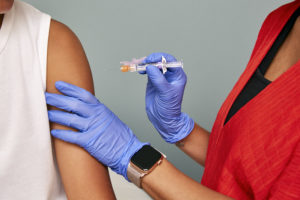By Sohini Roy

Asian lineage avian influenza virus (H7N9) is a subtype of influenza virus that can infect humans following exposure to live, infected poultry. There have been several outbreaks since the first reported case in China in 2013, and the mortality rate is as high as 39 percent. Although person-to-person transmission of the virus is unlikely, influenza viruses are constantly evolving into new strains. Therefore, there is a constant threat of emergence of more pathogenic and resistant viruses with the ability to trigger a worldwide pandemic outbreak.
Despite continued evaluation of numerous candidates, there is currently no licensed vaccine to prevent or treat H7N9 infection. A recent investigation from the lab of James Crowe (Pediatrics), led by postdoc Iuliia Gilchuk and published in Cell Host and Microbe, sought to change this paradigm by characterizing the protective capacity of monoclonal antibodies that can neutralize virus particles and potentially impair their reproduction.
Influenza viruses have two major surface glycoproteins: hemagglutinin (HA) and neuraminidase (NA). HA enables attachment and fusion of the virus to host cells, and NA, an enzyme, plays a crucial role in the release and spread of the newly synthesized virions; the name of flu viruses, such as H7N9, indicates which HA and NA molecules the virus has. Natural infection or vaccination induce humoral immunity, a process that activates antibody production by the body’s B cells and subsequent elimination of the pathogen or infected cells. Based on the current standard, anti-HA antibody levels are used as a measure of protective immunity and are the focus of vaccine formulations. The NA-induced immune response is not as well characterized and is therefore largely ignored in vaccine development. However, emerging evidence indicates that anti-NA antibodies have improved protective potential.
In the current study, the researchers isolated peripheral blood of H7N9 survivors and healthy vaccinees (people who had received a vaccine) and tested and characterized their antibody production in response to the virus. Although the survivors of natural infections responded to both H7 and N9, an adjuvant (a substance that enhances antibody production and lowers the required dose of antigen in a vaccine) was needed to induce a humoral response to N9 in the vaccinees. The anti-N9 antibodies harvested from survivors and vaccinees were subtype specific and did not cross-react with other NA proteins. Importantly, amino acid mutations in the N9 enzyme active site that commonly result in resistance to NA inhibitors (NI) did not affect antibody binding, indicating that they might be useful for treating NI-resistant cases.
Excitingly, when administered before an otherwise lethal infection with H7N9, anti-N9 antibodies harvested from vaccinees provided mice with complete protection against weight loss, morbidity, and mortality. The two best antibodies also successfully protected the mice from illness and weight loss even when administered one day after infection with an otherwise lethal dose of virus, indicating that the antibodies could treat H7N9 infection.
With more research highlighting the importance of the NA-specific humoral response in protecting against influenza, the current study is the first of its kind and provides critical information about how anti-N9 antibodies protect against influenza. This work reveals a vulnerability on N9 that can serve as a template for designing improved small molecule or recombinantly synthesized antibody vaccines. The findings from this study provide a new platform to fight H7N9 infection, including in cases where the virus is resistant to currently available antiviral therapies.
This research was funded by the National Center for Advancing Translational Sciences, the National Institutes of Health, the National Center for Research Resources, and the National Center for Advancing Translational Sciences.